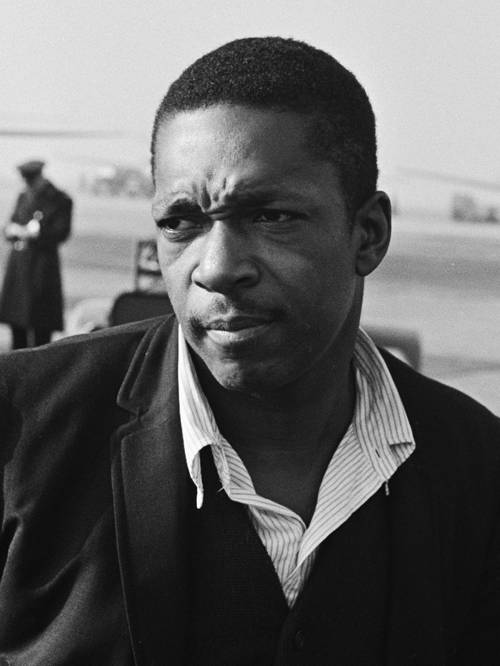
FAQ About John Coltrane

Who was John Coltrane?
John Coltrane was an American jazz saxophonist and composer, recognized as one of the most influential and innovative figures in the history of jazz. He was born on September 23, 1926, in Hamlet, North Carolina, and passed away on July 17, 1967. Coltrane played a significant role in the development of jazz music, especially with his work during the 1950s and 1960s, which expanded the boundaries of jazz improvisation and composition.

What are some of John Coltrane's most famous albums?
John Coltrane is renowned for several groundbreaking albums, including "Giant Steps" (1960), "A Love Supreme" (1965), "Blue Train" (1957), and "My Favorite Things" (1961). Each of these albums showcases Coltrane's innovative approach to jazz, blending complex musical structures with emotional and spiritual depth.

How did John Coltrane influence jazz music?
John Coltrane had a profound impact on jazz music by pioneering modal jazz and free jazz. His exploration of new scales, extensive improvisation, and complex compositions contributed to new directions in jazz. Coltrane's work inspired countless musicians and led to the development of new styles and approaches within the genre, influencing generations of jazz artists.

What is 'A Love Supreme' and why is it significant?
"A Love Supreme" is a jazz album released by John Coltrane in 1965. It is considered one of his masterpieces and a landmark recording in jazz history. The album is a four-part suite that expresses Coltrane's deep spirituality and quest for a higher understanding. Its significance lies in its innovative composition, emotional intensity, and its blending of spiritual themes with complex jazz structures.

Did John Coltrane play any instruments other than the saxophone?
While John Coltrane is primarily known for his work as a tenor and soprano saxophonist, he occasionally played other instruments, such as the clarinet and flute, during his career. However, it was his mastery of the saxophone that defined his sound and left a lasting legacy in jazz music.

What was John Coltrane's approach to improvisation?
John Coltrane's approach to improvisation was characterized by his extensive exploration of scales, his use of complex chord progressions, and his ability to express deep emotional and spiritual experiences through his music. He often employed a technique called "sheets of sound," which involved rapid sequences of notes that created dense, intricate musical textures.

What is the 'sheets of sound' technique associated with John Coltrane?
The "sheets of sound" technique is a term used to describe John Coltrane's innovative style of improvisation characterized by cascading patterns and rapid sequences of notes. This approach contributed to the creation of dense, intricate musical textures, which became a hallmark of Coltrane's playing style, especially evident in his work during the late 1950s.

How did John Coltrane's personal life influence his music?
John Coltrane's personal life had a significant impact on his music, particularly his spiritual awakening in 1957. This period marked a turning point in his career, as he began to explore deeper existential and spiritual themes in his compositions, which is most evident in albums like "A Love Supreme." His personal experiences and struggles were often reflected in the emotional intensity and depth of his music.

What other musicians did John Coltrane collaborate with?
Throughout his career, John Coltrane collaborated with numerous renowned musicians, including Miles Davis, Thelonious Monk, McCoy Tyner, Elvin Jones, and Jimmy Garrison, among others. These collaborations were pivotal in his development as a musician and helped form some of the most influential jazz groups in history.

What is modal jazz, and how did Coltrane contribute to it?
Modal jazz is a style of jazz that uses musical modes rather than chord progressions as the harmonic framework for improvisation. John Coltrane was instrumental in the development of modal jazz, particularly through his work on the album "Kind of Blue" with Miles Davis and his own compositions such as "Impressions" and "My Favorite Things," which employed modal structures.

Did John Coltrane receive any awards for his music?
John Coltrane received numerous posthumous awards and honors for his contributions to jazz music, including a Grammy Lifetime Achievement Award in 1992 and a Pulitzer Prize Special Citation in 2007. His album "A Love Supreme" has been inducted into the Grammy Hall of Fame, reflecting its enduring influence and significance.

How did John Coltrane's music evolve over his career?
John Coltrane's music evolved significantly over his career. In the early stages, he played bebop and hard bop, characterized by complex chord progressions and fast tempos. In the late 1950s, he began to explore modal jazz, reducing harmonic complexity to emphasize melody and improvisation. Later, in the 1960s, Coltrane delved into avant-garde and free jazz, where he experimented with dissonance and less-structured forms, seeking greater emotional and spiritual expression.

What is the legacy of John Coltrane in jazz music today?
John Coltrane's legacy in jazz music is immense. He is remembered as one of the greatest saxophonists and jazz innovators, whose work has influenced countless musicians across various genres. His contributions to modal and free jazz expanded the possibilities of jazz improvisation and composition. Today, his music continues to inspire new generations of musicians and remains a crucial part of the jazz canon.

What role did spirituality play in John Coltrane’s music?
Spirituality was a central theme in John Coltrane’s music, especially after his deep spiritual awakening in 1957. This period marked a significant transformation in his approach to music and life, with albums like "A Love Supreme" epitomizing his quest for spiritual enlightenment and expressing his faith through innovative compositions and profound emotional expression.

Why is "Giant Steps" considered a significant album in jazz?
"Giant Steps," released in 1960, is considered one of John Coltrane's masterpieces and a pivotal album in jazz history. The title track is notorious for its complex chord progressions, now known as 'Coltrane changes,' which challenged and expanded the vocabulary of jazz musicians. The album exemplifies Coltrane's technical prowess and innovation in jazz composition.

How did John Coltrane's collaboration with Miles Davis influence his career?
John Coltrane’s collaboration with Miles Davis was a crucial period in his career, profoundly influencing his musical development. Being part of the Miles Davis Quintet, Coltrane contributed to the groundbreaking album "Kind of Blue," which was pivotal in the development of modal jazz. This partnership allowed Coltrane to experiment and develop his distinctive sound, setting the stage for his subsequent innovations.

What was the impact of John Coltrane's album "Ascension"?
"Ascension," released in 1966, marked a significant moment in jazz history as it embraced the free jazz movement. This extended piece featured a large ensemble and was characterized by its abstract structure and collective improvisation. The album symbolized Coltrane’s move towards avant-garde jazz, pushing the boundaries of traditional jazz and influencing the future direction of the genre.

Where did John Coltrane’s interest in music begin?
John Coltrane's interest in music began in his childhood, influenced by his father who played several instruments. Coltrane started with the clarinet and moved to the alto saxophone. His deep engagement with music was further bolstered during high school and later at the Ornstein School of Music in Philadelphia, which laid the groundwork for his illustrious career in jazz.

What was the impact of John Coltrane's "Blue Train" album?
Released in 1957, "Blue Train" is one of John Coltrane's early masterpieces and an essential hard bop recording. The album is notable for its sophisticated compositions and Coltrane's emotive tenor saxophone playing. "Blue Train" helped to establish Coltrane's reputation and set the stage for his later modal and avant-garde explorations.

How did John Coltrane contribute to the development of free jazz?
John Coltrane contributed significantly to the development of free jazz, particularly through his work in the 1960s. He embraced the free jazz movement in albums like "Ascension" and "Interstellar Space," characterized by an emphasis on free collective improvisation, dissonance, and a move away from structured forms, influencing a new wave of jazz musicians dedicated to exploring musical liberation.
